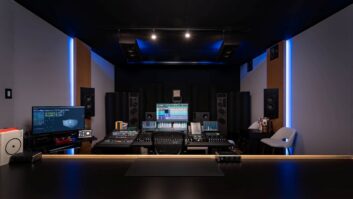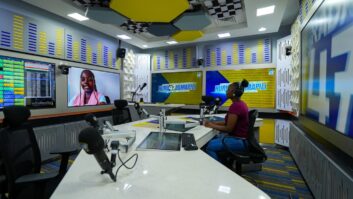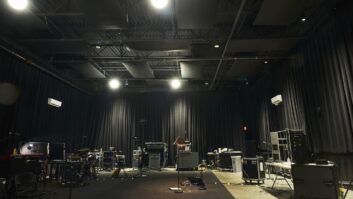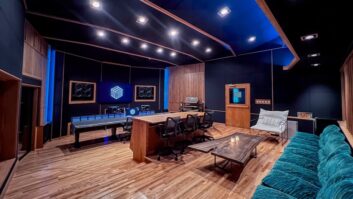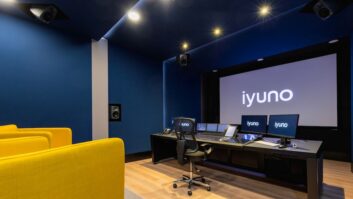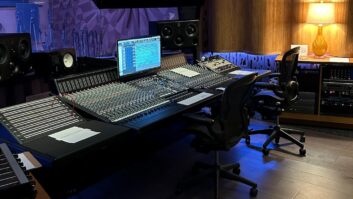No one would ever accuse Craig Huxley of being timid. In 1985 he opened a sprawling, Memphis-modern decorated, multiroom recording complex in Burbank and dubbed it The Enterprise, in honor of his tenure as a child actor with, and later composer for, the Star Trek television series. At the time, the space also housed his high-end equipment rental company, Audio Affects, and the facility quickly became a bustling warren of activity that hasn’t stopped since. Through constant upgrades and equipment changes, The Enterprise has continued to be busy and successful.
In 1998 Huxley took over a building across the street and gutted it, turning what had originally been Evergreen Studios, and more recently the second incarnation of Ground Control Studios, into E2, a top-of-the-line post-production facility complete with the SSL Avant digital console, an SSL J 9000-equipped scoring stage that can comfortably hold an 80-piece orchestra, and nine editing rooms.
Meanwhile, back at the original Enterprise, six rooms are online: The THX-certified Bridge, or Studio B, with its multilevel control room, 12×9-foot projection screen, film dubbers, M&K 5.1 DTS/Dolby AC-3 monitoring system and 101-channel SSL J 9000; C, The Cabin, also with a 101-in SSL J 9000; Studio E (for Energizer) fitted with an SSL 8000/80G; Mission Control (Studio M, of course) and A, Arena, both with Neve Capricorn digital consoles. There’s also a Pro Tools/ Synclavier/Sonic Solutions edit suite dubbed The Dock.
Recent projects in at The Enterprise have included Aerosmith with Mike Shipley engineering, Celine Dion with David Foster at the helm (75 pieces!), Mariah Carey with producer Randy Jackson, and Paul Westerberg working with Don Was. The Enterprise was one of the early studio players in music for film, DVD and surround sound, so when the building across the street, with its 100-space parking lot, became available, it’s not too surprising that Huxley’s thoughts turned to expansion.
“We wanted to expand our services to be able to take pre-production movie scores from the orchestral recording stage to the final high-bit 5.1 mixdown,” he explains.
The new scoring stage, with its walls moved out to enlarge the recording space, is a warm but live-sounding room with an airy feel and light wood floors. It has been host to scoring projects engineered by Bobby Fernandez and Armin Steiner, among others. Mix projects have run the gamut from film scores for Africa the Serengeti, Ring of Fire and Boyz II Men Live to music projects for Alan Parsons, Eric Clapton, the Allman Brothers and Beck, Bogart & Apice.
Stage X, designed from the ground up for dubbing, is the first U.S. installation of an SSL Avant. Andre Perreault is COO as well as lead mixer for E2, and it was largely his input that tipped the balance toward the Avant. Perreault, who has been with the Enterprise for three-and-a-half years, and who previously worked at POP, Hollywood Digital and BOP Studios in South Africa, is no stranger to digital consoles.
“I’ve worked with SSL for many years,” he says. “I was probably the first to run their Omnimix, which at the time, in ’92, was their new digital desk. I’ve also worked on the AMS Neve Logic 2, and on the Neve Capricorns here at Enterprise. I like technology, I’m not afraid of it. Yes, going to a digital console is an expensive decision to make, but there’s really no choice; you have to do it.
“Production schedules are so crazy nowadays, and there’s so much information to deal with-you can have 300 sound effects for one scene,” he continues. “You need a device that will let you reduce that quickly, but in a way that allows you to also easily backtrack and go in and make changes. You have to be able to work really fast, and you need equipment that will allow you to do that. All the normal, conventional analog desks are very sluggish, very slow, everything’s still manual. In the case of the Avant, everything’s fully automated. One of its best features is that it runs as a master, which, compared to the other desks, makes a big difference. The automation is alive at all times, even when no picture is rolling and no tapes are rolling. You can make automation moves and prepare your EQ, etc., as opposed to other desks where you have to roll back, then, once you’re at play speed, hope that you grab the move on time. With the Avant you can park on the frame and do all your moves, then press ‘play’ and go right from there. It’s extremely powerful.
“Mixing for film is a lot of fun, but it’s very complicated, and the more tools you have the easier it is,” Perreault says. “Mechanically, doing a film is very tough; there’s a lot going on, a lot of elements, and what the manufacturers need to do is to make your life simpler. The first digital console was practically the opposite of that-they wanted to make it full of menus and surfaces and switches. When you’re mixing to picture you don’t have time to switch around. Everything has to be fairly obvious and similar between layers. That’s another of the qualities of the Avant: Although it’s an extremely large and powerful system, it works like a normal desk, and you can get to what you need to do very quickly.
“We wanted to be the first ones to use it,” he adds, “and we jumped right in. That’s what we did with the Capricorn also. I knew it worked; we just bought one and went for it, when, at the time, no one else wanted to touch it. It’s been in two-and-a-half years, and a lot of other studios have them now. We love to be in at the beginning. You get better support from the company, and you can get pretty much what you want from them as they’re working on getting the product established. Also, I believe that what really makes a good facility is the crew, and the faster you get a crew onto the new technology, the better off you will be. It’s like the first time you do a movie-there’s a lot of stuff that can go wrong. But after ten movies, everything’s running just like clockwork. So if you’re going to buy new technology, you might as well do it as fast as you can so you can get up to speed and go.”
Projects done in Studio X since its opening include Jerry Springer’s Ringmaster, Paramount’s The Wood and Lomax’s Inferno, starring Jean Claude Van Damme, with Perreault as dialog and music mixer on all of them. He seems unfazed by his dual role as mixer and COO. “I manage the facility, yes, but I’m mostly in the studio and Ethan Bush is the operations manager,” he explains. “I come in early to see what’s going on, and then I basically mix every day. It’s always very tight schedule-wise here. It’s a small crew, and we try to achieve what we need without a lot of management. The sound supervisor runs his own show, and if he’s not happy it’s his problem and he needs to fix it. If I don’t like the stage, I can’t turn around and blame someone; I have to fix it.”
The exterior of E2 is still under construction. “Craig can tell you,” laughs Perreault. “You go one mile, and then you see there’s another mile to go and you have to do it. We were mixing long before the building was complete. We built it from the inside out, and now we are struggling to finally finish the outside.”

